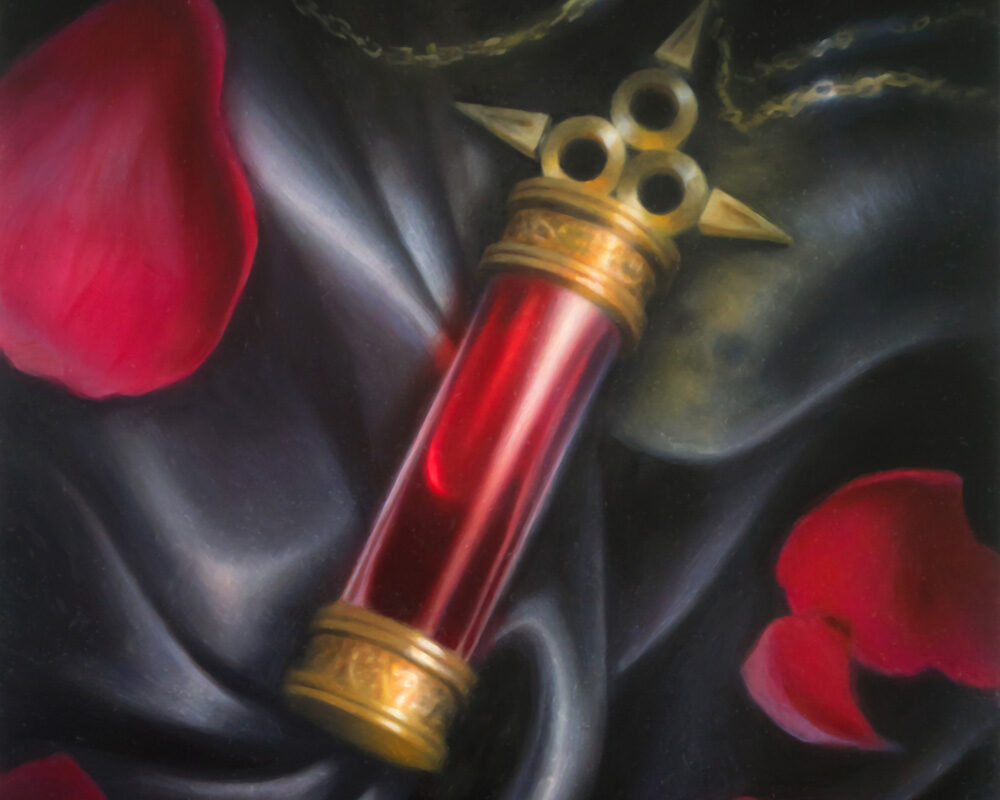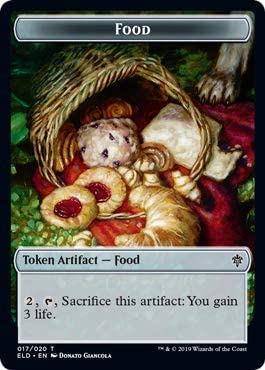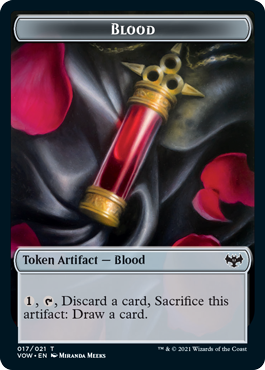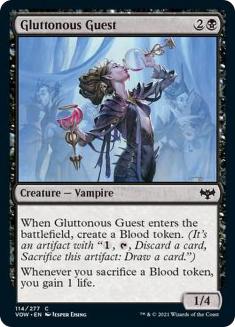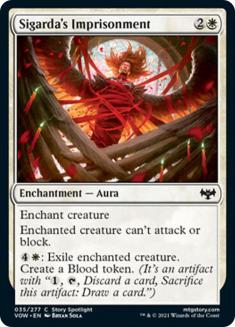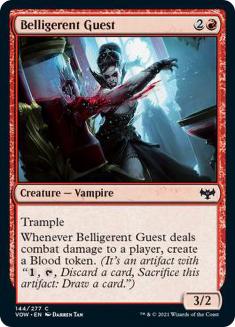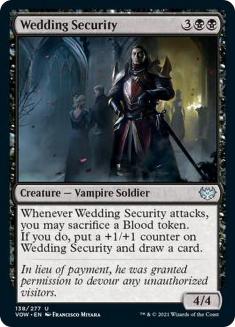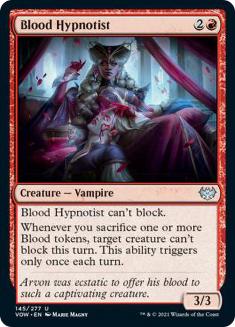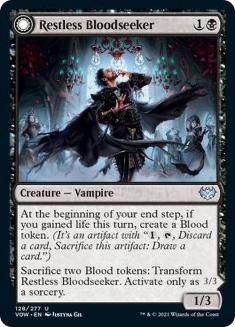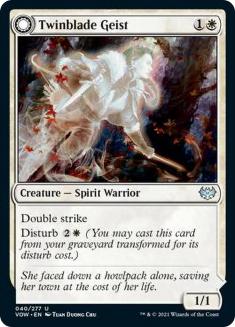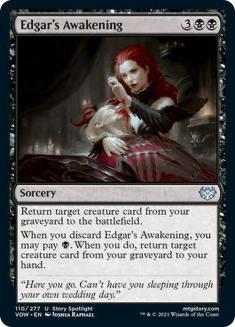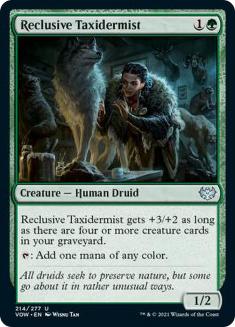Limited formats in the past few years often include a resource that stays on the battlefield. Innistrad: Crimson Vow introduces the Blood token, an artifact token, reminiscent of Food from Throne of Eldraine, that can be sacrificed for value. You could sacrifice a Food token for three life, and you can sacrifice a Blood token to discard a card and then draw a card.
Out of all the resources we have seen like this, I think Blood is my favorite. All of the best Limited formats have what is called “a smoothing mechanic.” The most famous mechanic like this is cycling. Whenever a smoothing mechanic is in a Limited set, it ensures that games play out with less mana flood or mana screw.
This also affects how decks are constructed. One of the aspects of cycling in Hour of Devastation Limited was that there were lands with cycling at common. My best decks in that format played nineteen lands! This is because, if I had many lands with cycling, I could never flood, which meant it was in my best interest to play multiple extra lands to ensure I could always play my land drops on time.
Blood won’t have the same magnitude of an impact on Innistrad: Crimson Vow as cycling lands had in Hour of Devastation, but it’s important to keep an eye on. It’s possible aggressively leaning decks that would normally play sixteen or even fifteen lands should play seventeen thanks to access to many Blood tokens.
Blood tokens seem to be a core part of the Rakdos identity, which makes sense because that guild is all about Vampires, who, well, need blood. However, Sigarda’s Imprisonment suggests that this resource isn’t tied to red or black. There’s even a Golgari rare, Old Rutstein, that creates Blood tokens.
I expect Rakdos to take advantage of this resource for more than just smoothing, while other archetypes simply use it like cycling. Think about Rakdos like Boros Cycling in Ikoria (although not as broken of course). Every deck in Ikoria Limited could include cards with cycling in order to smooth their draws, but only Boros tied cycling into how it won the game with cards like Zenith Flare.
It’s pretty clear that Blood tokens can provide a lot more than just discarding a card to draw a card, which is incredibly powerful. Think about Dimir in Innistrad: Midnight Hunt. Decayed Zombies could be used to tap creatures, set up your next draw, deal damage, and more. These tokens were pretty good in any deck, but Dimir took them to the next level. That’s what Rakdos will do with Blood in this format, and it may turn out to be the best deck because of it.
What would mostly get in the way of this is what I call “the Thopter problem.”
Magic Origins Limited supposedly supported an Izzet Thopters archetype, built around amassing a battlefield of 1/1 flying artifact creatures. But this deck didn’t actually exist. All the cards were there, but it was impossible to get a density in order to build a synergistic deck. This is because all the cards that created Thopter tokens were so good that every single blue and/or red deck drafted those cards highly. I don’t expect that to happen with Blood though, as that resource is worth quite a bit less than evasive creatures like Thopters.
To me, the important question I will try to answer early in the format is, “How valuable is a Blood token to non-Rakdos decks?”
The answer to this question helps in terms of card prioritization for every archetype, but it also helps gauge whether or not Rakdos will be able to run away with Blood synergy. And this question isn’t just about evaluating the text on the token itself, but also how different synergistic pieces align. For example, Restless Bloodseeker could easily end up being one of the best black uncommons if it’s easy to transform in any black deck. Futhermore, generic graveyard synergies across the board could make the ability to discard cards premium in any of the ten supported archetypes (although probably not any white aggressive deck).
Any deck with big creatures and discard outlets like Blood tokens will be happy to play Edgar’s Awakening. One mana to draw a card and a creature from the graveyard is an extremely good rate, and five mana to put a creature from your graveyard onto the battlefield is certainly solid in decks with top-end. While this is an obvious style of leveraging Blood tokens, the set has many others seeded across every color. There are many battlefields where an Aura wins the game, so much so that I can see myself casting a removal spell on my own Twinblade Geist in order to bring it back as an Aura. Blood tokens circumvent that massive hoop, as I can simply sequence my plan such that I discard Twinblade Geist instead of casting it like a creature.
There are also quite a few cards that gain a benefit from having multiple creatures in the graveyard, one of which is Reclusive Taxidermist, which is likely going to be a top green uncommon. If your opponent has a few Blood tokens, and a few creatures in their graveyard, are you really going to attack your 3/3 into their Reclusive Taxidermist? It’s pretty risky. This implies that Blood tokens can not only turn on synergies in any archetype, but also that their threat of activation can have a significant impact on certain battlefields.
Overall, If enough commons produce Blood tokens, I expect this particular resource to be format-warping, but in a good way. It should make decks more consistent, as well as enable many synergies. That’s exactly what I’m looking for in a set mechanic and I’m incredibly excited to play with this new resource!

